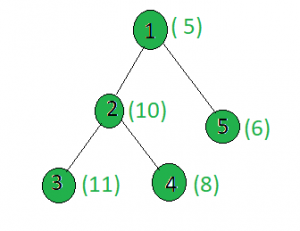给定一棵树,以及所有节点的权重和一个整数x ,任务是找到一个节点i ,以使weight [i] + x给出最小的置位位数,如果两个或多个节点的置位位数相同,则当与x相加,然后找到最小值的那个。
例子:
Input:

x = 15
Output: 1
Node 1: setbits(5 + 15) = 2
Node 2: setbits(10 + 15) = 3
Node 3: setbits(11 + 15) = 3
Node 4: setbits(8 + 15) = 4
Node 5: setbits(6 + 15) = 3
方法:在树上执行dfs并跟踪其与x的总和具有最小设置位的节点。如果两个或更多节点的设置位计数相等,则选择数量最少的一个。
下面是上述方法的实现:
C++
// C++ implementation of the approach
#include
using namespace std;
int minimum = INT_MAX, x, ans = INT_MAX;
vector graph[100];
vector weight(100);
// Function to perform dfs to find
// the minimum set bits value
void dfs(int node, int parent)
{
// If current set bits value is smaller than
// the current minimum
int a = __builtin_popcount(weight[node] + x);
if (minimum > a) {
minimum = a;
ans = node;
}
// If count is equal to the minimum
// then choose the node with minimum value
else if (minimum == a)
ans = min(ans, node);
for (int to : graph[node]) {
if (to == parent)
continue;
dfs(to, node);
}
}
// Driver code
int main()
{
x = 15;
// Weights of the node
weight[1] = 5;
weight[2] = 10;
weight[3] = 11;
weight[4] = 8;
weight[5] = 6;
// Edges of the tree
graph[1].push_back(2);
graph[2].push_back(3);
graph[2].push_back(4);
graph[1].push_back(5);
dfs(1, 1);
cout << ans;
return 0;
} Java
// Java implementation of the approach
import java.util.*;
class GFG{
static int minimum = Integer.MAX_VALUE,
x, ans = Integer.MAX_VALUE;
static Vector []graph =
new Vector[100];
static int []weight = new int[100];
// Function to perform dfs
// to find the minimum set
// bits value
static void dfs(int node,
int parent)
{
// If current set bits value
// is smaller than the current
// minimum
int a = Integer.bitCount(weight[node] + x);
if (minimum > a)
{
minimum = a;
ans = node;
}
// If count is equal to the
// minimum then choose the
// node with minimum value
else if (minimum == a)
ans = Math.min(ans, node);
for (int to : graph[node])
{
if (to == parent)
continue;
dfs(to, node);
}
}
// Driver code
public static void main(String[] args)
{
x = 15;
for (int i = 0; i < graph.length; i++)
graph[i] = new Vector();
// Weights of the node
weight[1] = 5;
weight[2] = 10;
weight[3] = 11;
weight[4] = 8;
weight[5] = 6;
// Edges of the tree
graph[1].add(2);
graph[2].add(3);
graph[2].add(4);
graph[1].add(5);
dfs(1, 1);
System.out.print(ans);
}
}
// This code is contributed by gauravrajput1 Python3
# Python3 implementation of the approach
from sys import maxsize
minimum, x, ans = maxsize, None, maxsize
graph = [[] for i in range(100)]
weight = [0] * 100
# Function to perform dfs to find
# the minimum set bits value
def dfs(node, parent):
global x, ans, graph, weight, minimum
# If current set bits value is greater than
# the current minimum
a = bin(weight[node] + x).count('1')
if minimum > a:
minimum = a
ans = node
# If count is equal to the minimum
# then choose the node with minimum value
elif minimum == a:
ans = min(ans, node)
for to in graph[node]:
if to == parent:
continue
dfs(to, node)
# Driver Code
if __name__ == "__main__":
x = 15
# Weights of the node
weight[1] = 5
weight[2] = 10
weight[3] = 11
weight[4] = 8
weight[5] = 6
# Edges of the tree
graph[1].append(2)
graph[2].append(3)
graph[2].append(4)
graph[1].append(5)
dfs(1, 1)
print(ans)
# This code is contributed by
# sanjeev2552C#
// C# implementation of the approach
using System;
using System.Collections;
using System.Collections.Generic;
using System.Text;
class GFG{
static int minimum = int.MaxValue, x,
ans = int.MaxValue;
static ArrayList[] graph = new ArrayList[100];
static int[] weight = new int[100];
static int PopCount(int n)
{
int count = 0;
while (n > 0)
{
count += n & 1;
n >>= 1;
}
return count;
}
// Function to perform dfs to find
// the minimum set bits value
static void dfs(int node, int parent)
{
// If current set bits value is smaller
// than the current minimum
int a = PopCount(weight[node] + x);
if (minimum > a)
{
minimum = a;
ans = node;
}
// If count is equal to the minimum
// then choose the node with minimum value
else if (minimum == a)
ans = Math.Min(ans, node);
foreach(int to in graph[node])
{
if (to == parent)
continue;
dfs(to, node);
}
}
// Driver Code
public static void Main(string[] args)
{
x = 15;
for(int i = 0; i < 100; i++)
graph[i] = new ArrayList();
// Weights of the node
weight[1] = 5;
weight[2] = 10;
weight[3] = 11;
weight[4] = 8;
weight[5] = 6;
// Edges of the tree
graph[1].Add(2);
graph[2].Add(3);
graph[2].Add(4);
graph[1].Add(5);
dfs(1, 1);
Console.Write(ans);
}
}
// This code is contributed by rutvik_56输出:
1
复杂度分析:
- 时间复杂度: O(N)。
在dfs中,树的每个节点都处理一次,因此,如果树中总共有N个节点,则由于dfs而导致的复杂度为O(N)。同样,为了处理每个节点,使用了internalin_popcount()函数,该函数的复杂度为O(c),其中c为常数,并且由于该复杂度为常数,因此不会影响整体时间复杂度。因此,时间复杂度为O(N)。 - 辅助空间: O(1)。
不需要任何额外的空间,因此空间复杂度是恒定的。